Chinese Journal of Tissue Engineering Research ›› 2023, Vol. 27 ›› Issue (16): 2556-2562.doi: 10.12307/2023.468
Previous Articles Next Articles
Systematic review of the research progress of nickel-titanium arch wires for orthodontics
Liu Wenwen1, Cui Zhanqin2, Liu Yingqi1
- 1Department of General Stomatology, Handan Central Hospital, Handan 056002, Hebei Province, China; 2Department of Orthodontics, Second Hospital of Hebei Medical University, Shijiazhuang 050001, Hebei Province, China
-
Received:2022-04-12Accepted:2022-08-08Online:2023-06-08Published:2022-11-11 -
Contact:Cui Zhanqin, Chief physician, Professor, Master’s supervisor, Department of Orthodontics, Second Hospital of Hebei Medical University, Shijiazhuang 050001, Hebei Province, China -
About author:Liu Wenwen, Master, Attending physician, Department of General Stomatology, Handan Central Hospital, Handan 056002, Hebei Province, China -
Supported by:a grant from Hebei Provincial Department of Finance, No. [2017]46 (to CZQ)
CLC Number:
Cite this article
Liu Wenwen, Cui Zhanqin, Liu Yingqi. Systematic review of the research progress of nickel-titanium arch wires for orthodontics[J]. Chinese Journal of Tissue Engineering Research, 2023, 27(16): 2556-2562.
share this article
Add to citation manager EndNote|Reference Manager|ProCite|BibTeX|RefWorks
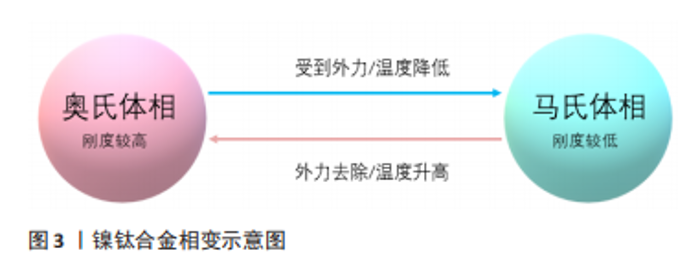
2.1 镍钛弓丝的种类 正畸用镍钛弓丝根据相变温度不同,可分为3类。①第一代为普通镍钛弓丝:其相变温度大于口腔温度,在口腔内呈现稳定的马氏体相,因此,该材料在临床应用过程中不表现超弹性和形状记忆特性。②第二代为超弹性镍钛弓丝:其相变温度小于口腔温度,在室温下处于非稳定的奥氏体相,进而可以通过应力诱导弓丝发生马氏体相变。因此,在临床使用过程中其可以表现超弹性,但不表现形状记忆特性,相较于第一代普通镍钛弓丝,其矫治时释放的矫治力更柔和、持久。③第三代为热激活镍钛弓丝:其相变温度值与口腔温度相近,室温下处于不稳定的马氏体相。在口腔环境中,当弓丝温度低于其相变温度时,弓丝刚度变小,弓丝温度高于其相变温度时,刚度变大,见图3。因此,第三代热激活镍钛弓丝刚性低、回弹性较好,同时具有超弹性和形状记忆性,在复诊时便于医师操作,并且可以对牙齿施加持续而柔和的矫治力,是正畸治疗过程中的理想选择[6]。"
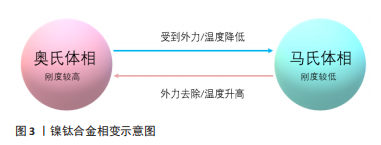
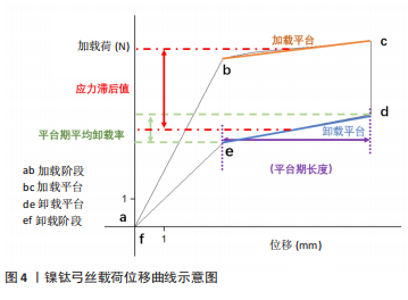
2.1.1 第一代镍钛弓丝 1962年,在美国海军军械实验室中,BUEHLER等[7]发现镍钛合金具有形状记忆特性,由此引发了材料界对于镍钛合金的广泛关注。1971年底,美国爱荷华大学的GEORGE ANDREASEN首次将镍钛合金引入正畸领域,通过实验证实镍钛弓丝在弹性极限、载荷-位移率、工作范围等方面均优于不锈钢弓丝[8-10],并由Unitek公司(现3M Unitek公司)以“Nitinol”为商品名首次将镍钛合金进行商业化销售[11]。相比于正畸治疗过程中传统的单股18-8不锈钢弓丝和不锈钢麻花丝的机械性能,Nitinol弓丝具有弹性模量较低、弹性好等优点[8]。并且,该弓丝具有较低的弹性模量和较好的使用范围[11]。虽然第一代镍钛弓丝相较于传统正畸弓丝已有较大进步,但其仍有不足之处,如矫治力量较大[12]、在临床环境中并不具备形状记忆效应[13],以及对于错位严重的牙齿无法提供持续而柔和的矫治力等。因此,镍钛合金材料仍需进一步改进。 2.1.2 第二代镍钛弓丝 1978年,日本Furwkawa Electric公司发明了一种新型镍钛弓丝,该弓丝不但具有第一代弓丝的良好回弹性,同时具有超弹性[12]。MIURA等[14]通过拉伸实验和特殊设计的三点弯曲实验证实了其具有特殊的载荷位移图像,即其载荷位移曲线可见明显的双平台(即加载平台和卸载平台),见图4。临床上体现为弓丝在恢复原始形状的过程中对牙齿施加的力值不随牙齿向矫治方向的移动而变小。"
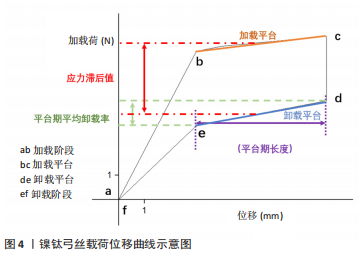
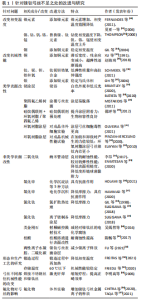
20世纪80年代初,北京有色金属研究总院和北京口腔医院共同研发出中国镍钛丝,这种弓丝同时具有超弹性和形状记忆特性,冶金部通过鉴定认定其特性优于美国Nitinol弓丝[12]。1986年,中国和日本的研究人员开发了“超弹性”镍钛合金[14-15]。这两种镍钛合金都是应力诱发马氏体相变的奥氏体合金[16]。20世纪90年代初,Neo Sentalloy问世[17],这是一种活性马氏体相合金。实验表明Neo Sentalloy弓丝在力值加载过程中具有伪弹性,在卸载过程中具有热弹性[17]。BRANTLEY等[18]通过差示扫描量热法分析得出,Neo Sentalloy在口腔温度下具有形状记忆特性。 20世纪90年代初期, 由日本国立东京齿科大学矫正学教研室相马邦道教授和日本TOMY公司研发与生产的一种改良超弹性钛镍弓丝,即低滞后镍钛弓丝。该弓丝的特点是:在口腔温度下就可以产生稳定的力量,即其被激活时产生的应力(包括转矩力)和移动牙齿时其慢慢恢复原状时产生的应力之差比其他镍钛丝要小[19]。LIAW等[20]比较了低滞后弓丝与传统超弹性镍钛弓丝的性能,得出低滞后弓丝具有更低的刚度和摩擦力。 超弹性镍钛弓丝可以在相当长的载荷范围内释放恒定的力,因此在正畸的初始阶段显著简化了治疗程序。然而,这种超弹性弓丝的低刚度限制了该材料在正畸治疗的关闭间隙阶段以及精细调整阶段的使用[21]。 2.1.3 第三代正畸弓丝 20世纪90年代,室温下为非稳定马氏体相的热激活镍钛合金弓丝开始进入市场[16]。其制作工艺是将弓丝在高温下成型后迅速降温,于低温下塑形,然后再升温到高温相,通过这样的循环处理,弓丝形状就能记忆在奥氏体相中[22]。不同于一代、二代镍钛弓丝,热激活镍钛弓丝相变温度为35 ℃左右,可以在口腔温度下发生相变,从而实现形状记忆功能[23]。BRANTLEY等[24]观察热激活镍钛弓丝和超弹性镍钛弓丝的相变过程,发现热激活镍钛弓丝在口腔温度下可以彻底转换到奥氏体相,但超弹性镍钛弓丝在口腔温度下已经完全处于奥氏体,因此无法在口腔温度下再发生相变,从而无法体现其形状记忆特性。在口腔环境中,热激活镍钛弓丝因受热而恢复弓丝“记忆”的原始形状,应力随之缓慢增加,并最终释放持续的矫治力来排齐牙齿。基于这一特性,LOMBARDO等[25]认为可以通过改变患者进食食物的温度来改变弓丝的矫治力,从而达到精确控制矫治力的目的。GRAVINA等[26]通过三点弯曲实验对比超弹性镍钛弓丝和热激活镍钛弓丝的机械性能,发现热激活镍钛弓丝的卸载力值相当于超弹镍钛弓丝的25%-30%,并且平台期更长、矫治力更轻柔。MAHMOODZADEH等[27]通过随机对照临床试验对比了59例患者,得出在治疗过程中使用热激活镍钛弓丝患者的疼痛小于相同尺寸的超弹性镍钛弓丝。KEERTHANA 等[28]通过前瞻性随机临床对照试验,得出热激活镍钛弓丝和超弹性镍钛弓丝在排齐阶段对于缓解下前牙拥挤的效果相同。此外,还有研究表明热激活镍钛弓丝更加柔软,受力后不易发生折断,并且排齐效率也高于普通镍钛弓丝[29]。 第三代镍钛弓丝以其优越的机械性能倍受医护人员关注,但值得注意的是,热激活镍钛弓丝除了价格昂贵,还存在一些不足,如摩擦力较大、易腐蚀、有镍离子渗出及美观性较差等缺点。针对上述问题,国内外学者采取了多种技术路线改进镍钛弓丝,为其取得良好的临床效果提供理论与数据支持。 经过多年的研究与实践,镍钛弓丝发展趋近于成熟,对第一、二、三代镍钛弓丝的各方面不足均有研究或改进,现进行总结,见表1。"
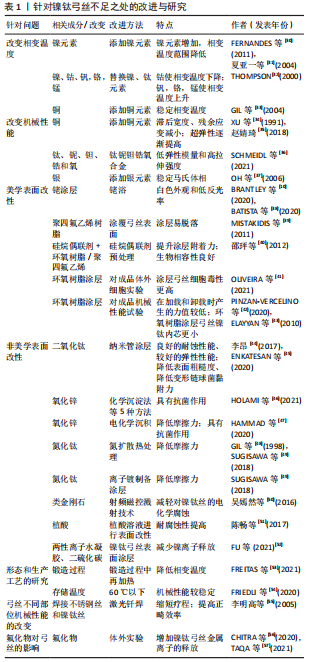

2.2 镍钛弓丝成分的改变对性能的影响 2.2.1 镍钛弓丝成分改变对相变温度值的影响 第一、二、三代镍钛合金,由于相变温度不同而在临床表现出不同的特性。因此,镍钛合金的相变温度可以通过诸如改变合金中镍及钛元素的比例、冷加工、热处理和添加第三种元素等方法来实现[58]。 FERNANDES等[30]通过分析镍钛合金的物理和力学性能,提出在镍钛合金中增加镍元素的含量,能够降低其相变温度范围并增大弓丝的奥氏体相屈服强度。夏亚一等[31]也提出了相似的结论,镍钛合金的相变温度对于镍元素含量的波动尤其敏感,当镍含量在55%-56%范围内时,镍元素含量每增加0.01%,其相变点可下降10 ℃左右,可以利用这一特性,生产相变温度适宜的产品。 此外,也有许多研究发现通过增加与镍或钛元素相似的其他化学元素而使镍钛合金相变温度发生改变。THOMPSON[32]提出增加镍元素含量或用钴替换镍能使相变温度在一定范围内下降,用钒、铬、锰等替换钛元素可以使相变温度上升。GIL等[33]通过研究对比不同铜含量的铜镍钛合金的相变温度、不同温度下的相变应力、超弹性等力学性能,发现添加铜元素可以使马氏体相变温度对镍钛比例的敏感性下降,同时也能降低滞后、稳定超弹性,且能提供更稳定的相变温度和矫治力量。 2.2.2 镍钛弓丝成分改变对弓丝机械性能的影响 20世纪90年代中期,由Ormco公司制造的含铜镍钛弓丝上市。XU等[34]通过实验得出,在镍钛合金中加入铜元素其滞后宽度较普通镍钛弓丝减小了三四倍。有学者通过比较不同成分铜镍钛合金的机械性能得出:随着镍钛合金中铜元素的增加,合金的残余应变变小,超弹性逐渐提高,并且抗腐蚀性能也有所提升[35]。 KEERTHANA等[28]通过临床试验证实,铜镍钛弓丝和奥氏体相镍钛(A-NiTi)弓丝对下前牙的排齐效果相似,且患者在疼痛程度方面没有显著差异;但当铜元素含量大于10%时,合金会由于脆性较大而导致该成分合金开裂严重,并且添加铜元素会在一定程度上抑制镍钛合金中镍离子的析出,这有利于对镍离子过敏患者适用的正畸弓丝研发。 2001年,日本丰田中央研发公司的冶金研究部门开发了一种新型多功能β-Ti合金,它由钛、铌、钽、锆和氧(TiNbTaZrO)组成,具有生物惰性,商品名为Gummetal[36]。制造商声称,弓丝晶体的位错运动(塑性变形)是完全受控的,这使得Gummetal独一无二[59]。根据Schmeidl等[36]的说法,与其他钛丝相比,Gummetal弓丝可以将弓丝和金属托槽之间的摩擦减少高达50%,它具有罕见的低弹性模量和高拉伸强度;通过体外实验对比了Gummetal和不锈钢、镍钛、钴铬和钛钼合金丝的滑动摩擦力,得出Gummetal的滑动摩擦力与镍钛和钴铬合金丝相似。 OH等[37]研究了镍钛-银三元合金的相变温度、显微组织、显微硬度、耐蚀性和细胞毒性等性能,提出在镍钛合金中添加银元素能稳定马氏体相,提高弓丝的抗腐蚀性。 2.3 镍钛弓丝的表面改性 由于水和氧气的作用,镍钛合金表面会自发形成二氧化钛致密层[60],但是这种涂层极易受到破坏,进而导致镍钛合金基底的腐蚀。研究表明,镍钛合金在腐蚀之后其拉伸强度会明显下降,弓丝容易发生折断,使用寿命变短[61-62]。HUNT等[63]通过极化电阻电化学技术估算了生理盐水中的相对腐蚀速率,得出镍钛合金的腐蚀会降低弓丝表面滑动性,延长正畸疗程。 为了增强弓丝耐腐蚀性、加强美观、减少镍元素释放、降低摩擦力及降低弓丝表面细菌附着,常对弓丝进行表面改性[64],现以美学和非美学表面改性两类进行阐述。 2.3.1 弓丝美学表面改性 研究表明,在大多数成年和大部分青少年正畸患者中,都倾向于选择更小巧美观的矫治器以保持美观[38],这使得从20世纪70年代开始,许多厂家开始研发更美观、隐形的矫治器。同时,为了保证正畸疗效,需要美学正畸弓丝同时具有金属弓丝的力学性能。自此,多位厂家和学者做出了大量的尝试和研究。 最早应用于弓丝表面改性的是聚四氟乙烯和环氧树脂。在21世纪初,表面涂覆有含氟树脂(如聚四氟乙烯树脂或环氧聚四氟乙烯树脂等[39])的镍钛弓丝成品已经上市,但是在临床使用中普遍存在涂层易脱落等问题[40]。在2012年,邵玶等[40]首先提出采用硅烷偶联剂对钛镍合金表面进行处理,随后在弓丝表面制备牙本色环氧树脂/聚四氟乙烯涂层的方法,可以使涂层附着力明显提升,并具有良好的生物相容性。但OLIVEIRA等[41]通过体外实验得出人牙龈成纤维细胞暴露于环氧树脂涂层镍钛弓丝30 d后,其细胞毒性比暴露在未涂层弓丝下的更高。同时,PINZAN-VERCELINO等[42]发现环氧树脂涂层弓丝和同尺寸镍钛弓丝的机械性能具有一定差异,并且环氧树脂涂层弓丝较其他涂层弓丝的金属内芯直径更小。ELAYYAN等[43]通过三点弯曲实验得出,与同尺寸超弹性镍钛弓丝相比,环氧树脂涂层弓丝在加载和卸载时产生的力值更低。 近年来,随着材料学的发展,一种用于首饰加工的工艺被应用在弓丝涂层上,即“铑浴”[38]。铑涂层具有白色外观和低反光率[10]。BATISTA等[38]综合了正畸医师以及非专业人士对聚四氟乙烯、环氧树脂和铑涂层弓丝的美观性打分,得出铑涂层弓丝是这三者中评价最高的,最为美观。 在微生物附着方面,OLIVEIRA等[41]通过体外实验对比了以上几种美学弓丝和普通镍钛弓丝经过培养后生物膜附着情况,发现不同涂层弓丝的生物膜附着情况没有明显区别。 在机械性能方面,BATISTA等[65]对比了GAC?和Aditek?两个公司生产的美学弓丝和相对应的普通弓丝进行了三点弯曲实验,发现在绝大多数位移的情况下两种弓丝的力值没有统计学差异。在PINZAN-VERCELINO等[42]的实验中,具有铑涂层的热激活镍钛弓丝和无涂层热激活镍钛弓丝在卸载位移分别为0.5,1.0,2.0 mm时的力值相似,而具有铑涂层的热激活镍钛弓丝在卸载位移为3 mm时的力值高于无涂层热激活镍钛弓丝。有环氧树脂涂层的NiTi弓丝仅在卸载位移1 mm时表达出与无涂层NiTi弓丝相似的力值。临床上可以利用这一特性,选择合适的弓丝。 除此以外,还有镀银镍钛弓丝[10]、银加聚合物涂层镍钛弓丝[41]、银铂合金、聚合物双涂层的弓丝等弓丝的报道[10],这些弓丝的美学、生物相容性、机械性能等仍待研究。 2.3.2 镍钛弓丝的非美学表面改性 纳米管涂层是表面改性的重要方法之一,能有效提高合金的耐腐蚀及抗菌性能[66]。李昂[44]研究得出被覆二氧化钛(TiO2)纳米管的镍钛弓丝具有良好的耐蚀性能并保持了较好的弹性性能。ENKATESAN等[45]也研发了TiO2纳米颗粒涂层,可降低表面粗糙度和变形链球菌黏附力,有助于减少正畸期间龋病的发生。 在众多金属氧化物中,氧化锌在橡胶工业、化妆品、医药生产、紫外线激光和电子工业中有着广泛的实际应用。HOLAMI等[46]通过化学沉淀法、化学气相沉积法、静电纺丝法、聚合物复合涂层法和溶胶-凝胶法共5种方法分别制备了不同形状和尺寸的氧化锌纳米结构,对镍钛弓丝进行表面改性,结果表明所有方法制备的样品均有抗菌作用。HAMMAD等[47]通过电化学沉积的方法在镍钛弓丝上涂覆氧化锌纳米颗粒,经过实验证实在镍钛丝上获得了稳定的氧化锌纳米涂层,涂层钢丝对金黄色葡萄球菌、化脓性葡萄球菌和大肠杆菌具有显著的抗菌活性,并且弓丝表面摩擦力降低34%,不仅可以减少龋坏发生,还可以提高正畸效率。利用氧化锌进行表面改性具有较低的成本以及较好的效果,有望在将来进入正畸实践。 GIL等[48]通过氮扩散热处理制备了氮化钛涂层,以减少镍钛弓丝的摩擦。SUGISAWA等[49]通过离子镀的方式在镍钛弓丝上制备了氮化钛涂层,发现弓丝耐腐蚀性提高、摩擦力降低。 类金刚石以其优越的性能,例如超硬、低摩擦、化学惰性和耐腐蚀等成为弓丝表面改性的热门材料。20世纪初,人们利用化学气相沉积或者物理气相沉积等方法将类金刚石应用到托槽和正畸弓丝等材料上,并研究其生物安全性以及摩擦学性 能[67-68]。吴嫣然等[50]采用射频磁控溅射技术在镍钛丝表面制备类金刚石,结果显示类金刚石可以减轻对镍钛丝的电化学腐蚀,但氟离子浓度增加及pH值降低均会影响其抗腐蚀性。 植酸对金属离子有络合作用,且能够在金属表面形成致密坚固的单分子保护膜,从而抑制金属的氧化腐蚀。陈畅等[51]用植酸溶液对正畸镍钛合金弓丝进行表面改性,并进行耐腐蚀性观察和机械性能检测,证实植酸可以有效缓解镍钛弓丝腐蚀现象,并不影响弓丝机械性能。 镍钛弓丝在体液环境下出现腐蚀后会释放镍离子,可能由此产生过敏反应。FU等[52]提出了一种通过两性离子水凝胶作为抗菌层和二硫化碳组分作为镍捕集剂组合的镍离子捕集策略,一方面,可以通过抑制细菌黏附,减少镍钛腐蚀产生的镍离子泄漏;另一方面,镍捕集器通过螯合反应主动捕捉镍钛合金中泄漏的镍离子,在实验室阶段取得了较理想效果。 以上多种涂层及表面改性方法,大部分仍处于实验室阶段,由于口腔环境以及正畸过程的复杂性,其远期效果、稳定性等问题仍需要高质量随机对照临床试验进行证实。 2.4 镍钛弓丝形态和生产工艺研究 在正畸弓丝的生产过程中,生产工艺的差距也会影响到弓丝的机械性能。SAPATA等[69]使用差示扫描量热法和三点弯曲实验评估了5个不同厂家相同尺寸的热激活镍钛弓丝的相变温度和卸载力值,结果显示所有厂家生产的的镍钛合金同一批次之间无差异,但是不同厂家之间均存在明显差异。SARUL等[70]对4个不同厂家生产的镍钛弓丝进行了分形维数分析和纹理分析,发现大多数弓丝之间,甚至是同一根弓丝不同表面之间的表面形态均具有较大差距。 FREITAS等[53]通过实验得出,在富镍镍钛合金(含有50.8%镍)锻造各步骤之间以950 ℃/120 min进行再加热,可以使成品呈现出较低的相变温度,从而生产出具有超弹性的镍钛弓丝。 TACHI等[71]通过体外实验测试了不同弓形(卵圆形,尖圆形,方圆形)的弓丝对每颗牙齿表达的正畸力,发现预成型弓丝的宽度测量值和其提供的正畸力之间存在显著相关性,即弓丝的尖牙间宽度与对中切牙和第一磨牙施加的正畸力呈显著负相关;弓丝的尖牙间宽度与对尖牙施加的正畸力呈显著正相关。并且,即便是初始阶段,细镍钛丝同样可以使尖牙间牙弓宽度变宽。因此,当应用的预制弓丝不适合该牙弓时,可能会产生不希望的颊向或舌向矫治力,这可能会增加牙根吸收和治疗后复发的风险[72]。同时,之前的研究显示,没有普遍适用于所有正畸患者的单一理想弓形[73],因此临床上在选择弓丝弓形时应该更加谨慎。 在镍钛弓丝预成型工艺方面,SUWANKOMONKUL等[74]通过体外研究得出,镍钛弓丝通过冷硬弯曲和直接电阻热处理两种方法预成型对其机械性能和相变温度没有影响。 由于镍钛和铜镍钛丝具有特殊的温度敏感性,其机械性能可能会受到储存温度的影响。FRIEDLI等[54]在实验室条件下分析了储存温度对正畸钢丝力学性能的影响,发现镍钛弓丝在不同温度下储存后表现出的机械性能存在统计学差异,并且建议选择储存在60 ℃以下的镍钛弓丝,以获得稳定的机械性能。 2.5 镍钛弓丝的其他改进 2.5.1 弓丝不同部位机械性能的改变 由于正畸治疗的复杂性,在治疗过程中的3个阶段内需要弓丝发挥不同的作用,而且即使在同一时期,有时一根弓丝也难以满足牙列中牙齿各类移动的需求。因此,许多学者针对这一需求对弓丝进行了改进。 为充分利用镍钛合金的超弹性和不锈钢的刚度,李明高等[55]采用激光钎焊方法焊接镍钛与不锈钢正畸矫治弓丝,制备复合矫治弓丝CoAW,并通过237例临床试验证明其具有明显的缩短疗程、提高正畸效率的优点。同时,ASADI等[4]采用Nd:YAG激光焊接设备焊接镍钛弓丝和304不锈钢丝,并得出焊接后在200 ℃加热1 h后淬火,可以更好地释放焊接区的残余应力,提高弓丝抗拉强度和应变。 由于前后牙牙周膜面积不同,因此矫治过程中为避免牙周组织损伤,前牙需要施加比后牙更轻的力,针对这一问题,CANNON和THOMPSON分析了由不同刚度的机械连接部分组成的弓丝“Dual-Flex archwires”(Lancer Orthodontics,Carlsband,CA,USA),即所谓的“双挠度弓丝”。2019年LOMBARDO等[75]将镍钛多力弓丝(GC?和ACME?)、铜镍钛多力弓丝和普通镍钛弓丝 对比,并得出多力弓丝可以提供更轻、更持久和恒定的力量。对于镍钛弓丝的改进涉及多个方面,但总体来说,弓丝的制作相对于研发新的合金以及表面改性来说更简单、也更加灵活。在临床操作过程中,医师可以根据不同错颌畸形的情况灵活选择并使用,不过目前尚未见到大规模的随机对照研究以确定其相对于传统弓丝的优越性,因此仍需进一步研究。 2.5.2 氟化物对弓丝的影响 固定矫治过程中,在托槽及带环的周围可能会出现脱矿白斑,这是龋病的早期症状。通常情况下,医师会建议正畸患者应用氟化物预防白斑和龋齿形成。但是早在2005年,有学者提出镍钛弓丝暴露在中性和酸性氟化物后其机械性能会有所降低。MANE等[76]通过体外实验证实了这一观点,并提出氟化物会腐蚀弓丝表面。KASSAB等[77]通过模拟口腔环境中的电化学测试证实,在含氟的体液环境中镍钛会出现局部腐蚀,甚至有断裂风险。CHITRA等[56]和TAQA等[57]也分别通过实验得出,氟化物的应用会增加镍钛弓丝金属离子的释放,改变其表面化学成分。因此,在正畸过程中应用氟化物需要谨慎考虑其中利弊。"

| [1] JIANG J, HUANG Z, MA X, et al. Establishment and Experiment of Utility Archwire Dynamic Orthodontic Moment Prediction Model. IEEE Trans Biomed Eng. 2020;67(7):1958-1968. [2] JIANG J, ZHANG Y, WEI C, et al. A review on robot in prosthodontics and orthodontics. Adv Mech Eng. 2015;7(1):198748. [3] NEMATZADEH F, SADRNEZHAAD SK. Effects of the ageing treatment gn the superelastic behavior of a nitinol stent for an application in the esophageal duct: a finite-element analysis. Mater Tehnol. 2013;47(4): 453-459. [4] ASADI S, SAEID T, VALANEZHAD A, et al. The effect of annealing temperature on microstructure and mechanical properties of dissimilar laser welded superelastic NiTi to austenitic stainless steels orthodontic archwires. J Mech Behav Biomed Mater. 2020;109:103818. [5] 童菲,吴建勇,唐镇,等.不同温度下正畸镍钛方丝超弹性及热弹性的对比研究[J].口腔医学研究,2012,28(10):1028-1031. [6] 童菲,吴建勇.镍钛合金丝的超弹性及热弹性的研究进展[J].实用临床医学,2009,10(4):129-130,132. [7] BUEHLER WJ, GILFRICH JV, WILEY RC. Effect of low‐temperature phase changes on the mechanical properties of alloys near composition TiNi. J Appl Phys. 1963;34(5):1475-1477. [8] ANDREASEN GF, HILLEMAN TB. An Evaluation of 55 Cobalt Substituted Nitinol Wire for Use in Orthodontics. J Am Dent Assoc. 1971;82(6): 1373-1375. [9] ANDREASEN GF, BRADY PR. A use hypothesis for 55 Nitinol wire for orthodontics. Angle Orthod. 1972;42(2):172-177. [10] BRANTLEY WA. Evolution, clinical applications, and prospects of nickel-titanium alloys for orthodontic purposes. J World Fed Orthod. 2020;9(3S):S19-S26. [11] KUSY RP, WHITLEY JQ. Resistance to sliding of orthodontic appliances in the dry and wet states: influence of archwire alloy, interbracket distance, and bracket engagement. J Biomed Mater Res. 2000;52(4):797-811. [12] 田华.正畸用超弹镍钛弓丝和热激活弓丝机械性能对比研究[D].长春:吉林大学,2012. [13] KUSY RP. A review of contemporary archwires: their properties and characteristics. Angle Orthod. 1997;67(3):197-207. [14] MIURA F, MOGI M, OHURA Y, et al. The super-elastic property of the Japanese NiTi alloy wire for use in orthodontics. Am J Orthod Dentofacial Orthop. 1986;90(1):1-10. [15] BURSTONE CJ, QIN B, MORTON JY. Chinese NiTi wire--a new orthodontic alloy. Am J Orthod. 1985;87(6):445-452. [16] CHANG HP, TSENG YC. A novel β-titanium alloy orthodontic wire. Kaohsiung J Med Sci. 2018;34(4):202-206. [17] MERTMANN M. Processing and quality control of binary NiTi shape memory alloys. Shape memory implants. Springer, Berlin, Heidelberg. 2000:24-34. [18] BRANTLEY WA, IIJIMA M, GRENTZER TH. Temperature-modulated DSC provides new insight about nickel-titanium wire transformations. Am J Orthod Dentofacial Orthop. 2003;124(4):387-394. [19] 乔文兰.运用LH钛镍丝与传统弓丝序列正畸疗程的对比研究[D].济南:山东大学,2010. [20] LIAW YC, SU YY, LAI YL, et al. Stiffness and frictional resistance of a superelastic nickel-titanium orthodontic wire with low-stress hysteresis. Am J Orthod Dentofacial Orthop. 2007;131(5):578.e12-8. [21] KHOO ZX, LIU Y, AN J, et al. A Review of Selective Laser Melted NiTi Shape Memory Alloy. Materials (Basel). 2018;11(4):519. [22] 吕海燕,葛红珊.正畸温控型镍钛合金弓丝的实验研究进展[J].江西医学院学报,2009,49(8):119-121. [23] MULLINS WS, BAGBY MD, NORMAN TL. Mechanical behavior of thermo-responsive orthodontic archwires. Dent Mater. 1996;12(5):308-314. [24] BRANTLEY WA, IIJIMA M, GRENTZER TH. Temperature-modulated DSC study of phase transformations in nickel–titanium orthodontic wireJ]. Thermochimica Acta. 2002;392:329-337. [25] LOMBARDO L, TONI G, STEFANONI F, et al. The effect of temperature on the mechanical behavior of nickel-titanium orthodontic initial archwires. Angle Orthod. 2013;83(2):298-305. [26] GRAVINA MA, BRUNHARO IH, CANAVARRO C, et al. Mechanical properties of NiTi and CuNiTi shape-memory wires used in orthodontic treatment. Part 1: stress-strain tests. Dental Press J Orthod. 2013;18(4):35-42. [27] MAHMOUDZADEH M, FARHADIAN M, ALIJANI S, et al. Clinical comparison of two initial arch wires (A-NiTi and Heat Activated NiTi) for amount of tooth alignment and perception of pain: A randomized clinical trial. Int Orthod. 2018;16(1):60-72. [28] KEERTHANA P, CHITRA P. Alleviation of Lower Anterior Crowding with Super- Elastic and Heat-Activated NiTi Wires: A Prospective Clinical Trial. Turk J Orthod. 2021;34(2):127-135. [29] 高洁,马锐,葛振林.热激活镍钛弓丝矫治效率的系统评价[J].国际口腔医学杂志,2019,46(4):393-399. [30] FERNANDES DJ, PERES RV, MENDES AM, et al. Understanding the shape-memory alloys used in orthodontics. ISRN Dent. 2011;2011:132408. [31] 夏亚一,陈峰,王天民.镍钛形状记忆合金性能的生物相容性研究进展[J].生物骨科材料与临床研究,2004,1(3):31-33. [32] THOMPSON SA. An overview of nickel-titanium alloys used in dentistry. Int Endod J. 2000;33(4):297-310. [33] GIL FJ, SOLANO E, PEÑA J, et al. Microstructural, mechanical and citotoxicity evaluation of different NiTi and NiTiCu shape memory alloys. J Mater Sci Mater Med. 2004;15(11):1181-1185. [34] XU H, MÜLLER I. Effect of mechanical vibration, heat treatment and ternary addition on the hysteresis in shape memory alloys. J Mater Sci. 1991;26(6):1473-1477. [35] 赵婧琦.含铜TiNi基形状记忆合金的组织与性能研究[D].哈尔滨:哈尔滨工程大学材料科学与工程,2018. [36] SCHMEIDL K, WIECZOROWSKI M, GROCHOLEWICZ K, et al. Frictional Properties of the TiNbTaZrO Orthodontic Wire—A Laboratory Comparison to Popular Archwires. Materials. 2021;14(21):6233. [37] OH KT, JOO UH, PARK GH, et al. Effect of silver addition on the properties of nickel-titanium alloys for dental application. J Biomed Mater Res B Appl Biomater. 2006;76(2):306-314. [38] BATISTA DM, FACCINI M, VALARELLI FP, et al. Attractiveness of different esthetic orthodontic wires. Dental Press J Orthod. 2020;25(6):27-32. [39] MISTAKIDIS I, GKANTIDIS N, TOPOUZELIS N. Review of properties and clinical applications of orthodontic wires. Hell Orthod Rev. 2011;14:45-66. [40] 邵玶,隋解和,冯雪,等.TiNi合金牙弓丝表面环氧树脂/聚四氟乙烯涂层的组织结构与性能[J].稀有金属材料与工程,2012,41(5): 822-825. [41] OLIVEIRA DC, THOMSON JJ, ALHABEIL JA, et al. In vitro Streptococcus mutans adhesion and biofilm formation on different esthetic orthodontic archwires. Angle Orthod. 2021;91(6):786-793. [42] PINZAN-VERCELINO CRM, DE ARAÚJO GURGEL J, BRAMANTE FS, et al. Coated nickel titanium archwires and their uncoated counterparts: In-vitro contemporary comparison of unloading forces. Int Orthod. 2020;18(2):374-379. [43] ELAYYAN F, SILIKAS N, BEARN D. Mechanical properties of coated superelastic archwires in conventional and self-ligating orthodontic brackets. Am J Orthod Dentofacial Orthop. 2010;137(2):213-217. [44] 李昂.TiO2纳米管涂层对镍钛弓丝耐蚀性影响的研究[D].沈阳:中国医科大学口腔临床医学,2017. [45] ENKATESAN K, KAILASAM V, PADMANABHAN S. Evaluation of titanium dioxide coating on surface roughness of nickel-titanium archwires and its influence on Streptococcus mutans adhesion and enamel mineralization: A prospective clinical study. Am J Orthod Dentofacial Orthop. 2020;158(2):199-208. [46] HOLAMI M, ESMAEILZADEH M, KACHOEI Z, et al. Influence of Physical Dimension and Morphological-Dependent Antibacterial Characteristics of ZnO Nanoparticles Coated on Orthodontic NiTi Wires. Biomed Res Int. 2021;2021:6397698. [47] HAMMAD SM, EL-WASSEFY NA, SHAMAA MS, et al. Evaluation of zinc-oxide nanocoating on the characteristics and antibacterial behavior of nickel-titanium alloy. Dental Press J Orthod. 2020;25(4):51-58. [48] GIL FJ, SOLANO E, CAMPOS A, et al. Improvement of the friction behaviour of NiTi orthodontic archwires by nitrogen diffusion. Biomed Mater Eng. 1998;8(5-6):335-342. [49] SUGISAWA H, KITAURA H, UEDA K, et al. Corrosion resistance and mechanical properties of titanium nitride plating on orthodontic wires. Dent Mater J. 2018;37(2):286-292. [50] 吴嫣然,杨陆一,刘军,等.类金刚石涂层与未涂层镍钛丝在人工唾液中耐腐蚀性能的比较[J].吉林大学学报(医学版),2016,42(3): 517-522. [51] 陈畅,刘士臣,李晓光,等.植酸溶液对正畸镍钛弓丝耐腐蚀性及机械性能研究[J].中国体视学与图像分析,2017,22(4):404-409. [52] FU X, LIU X, HAO D, et al. Nickel-Catcher-Doped Zwitterionic Hydrogel Coating on Nickel-Titanium Alloy Toward Capture and Detection of Nickel Ions. Front Bioeng Biotechnol. 2021;9:698745. [53] FREITAS RODRIGUES P, TEIXEIRA RS, LE SÉNÉCHAL NV, et al. The Influence of the Soaking Temperature Rotary Forging and Solution Heat Treatment on the Structural and Mechanical Behavior in Ni-Rich NiTi Alloy. Materials (Basel). 2021;15(1):63. [54] FRIEDLI L, NALABOTHU P, BOSCH C, et al. Influence of different storage temperatures on the mechanical properties of NiTi, Cu-NiTi and SS orthodontic archwires: An in vitro study. Int Orthod. 2020;18(3): 561-568. [55] 李明高,邱小明,孙大谦,等.TiNi 形状记忆合金与不锈钢的激光钎焊及其应用[J].中华口腔医学杂志,2005,40(4):270. [56] CHITRA P, PRASHANTHA GS, RAO A. Effect of fluoride agents on surface characteristics of NiTi wires. An ex vivo investigation. J Oral Biol Craniofac Res. 2020;10(4):435-440. [57] TAQA AA, AL-HAFIDH NN, AL-ABBOOD MTS. The effect of fluoride gel on tensile properties, surface morphology and chemical composition of two types of orthodontic wires (an in-vitro study). J Orthod Sci. 2021;10:14. [58] 林军,董陈,赵研,等.三种相变点正畸镍钛合金弓丝的力学性能比较[J].浙江大学学报(医学版),2007,36(5):503-508. [59] SAITO T, FURUTA T, HWANG JH, et al. Multifunctional Alloys Obtained via a Dislocation-Free Plastic Deformation Mechanism. Science. 2003; 300(5618):464-467. [60] PRYMAK O, KLOCKE A, KAHL-NIEKE B, et al. Fatigue of orthodontic nickel–titanium (NiTi) wires in different fluids under constant mechanical stress. Mat sci Eng A-struct. 2004;378(1-2):110-114. [61] 郭静,米丛波.4种镍钛正畸弓丝钛离子析出量的体外实验研究[J].口腔医学研究,2015,31(4):328-331. [62] ULFF N, BOUBY C, LACHIGUER A, et al. Modeling of Hydrogen Effects on the Thermomechanical Behavior of NiTi-Based Shape Memory Alloys. Shap Mem Superelasticity. 2019;5(3):206-217. [63] HUNT NP, CUNNINGHAM SJ, GOLDEN CG ,et al. An investigation into the effects of polishing on surface hardness and corrosion of orthodontic archwires. Angle Orthod. 1999;69(5):433-440. [64] HUANG SY, HUANG JJ, KANG T, et al. Coating NiTi archwires with diamond-like carbon films: reducing fluoride-induced corrosion and improving frictional properties. J Mater Sci Mater Med. 2013;24(10): 2287-2292. [65] BATISTA CH, NEVES JG, TEROSSI DE GODOI AP, et al. Comparison of force delivery of thermally activated aesthetic and non-aesthetic Ni-Ti wires: An in-vitro study. Int Orthod. 2020;18(2):359-365. [66] MA M, KAZEMZADEH-NARBAT M, HUI Y, et al. Local delivery of antimicrobial peptides using self-organized TiO2 nanotube arrays for peri-implant infections. J Biomed Mater Res A. 2012;100(2):278-285. [67] KOBAYASHI S, OHGOE Y, OZEKI K, et al. Dissolution effect and cytotoxicity of diamond-like carbon coatings on orthodontic archwires. J Mater Sci Mater Med. 2007;18(12):2263-2268. [68] MUGURUMA T, IIJIMA M, BRANTLEY WA, et al. Frictional and mechanical properties of diamond-like carbon-coated orthodontic brackets. Eur J Orthod. 2013;35(2):216-222. [69] SAPATA VM, SAPATA DM, ARAÚJO GURGEL J, et al. DSC analysis and evaluation of forces released on deactivation of 0.40-mm (0.016”) orthodontic thermo-activated NiTi wires: An in vitro study. J Dent Res Dent Clin Dent Prospects. 2020;14(1):12-18. [70] SARUL M, KOZAKIEWICZ M, JURCZYSZYN K. Surface Evaluation of Orthodontic Wires Using Texture and Fractal Dimension Analysis. Materials (Basel). 2021;14(13):3688. [71] TACHI A, TOCHIGI K, SAZE N, et al. Impact of the prefabricated forms of NiTi archwires on orthodontic forces delivered to the mandibular dental arch. Prog Orthod. 2021;22(1):41. [72] LUCCHESE A, MANUELLI M, ALBERTINI P, et al. Transverse and torque dental changes after passive self-ligating fixed therapy: A two-year follow-up study. Am J Orthod Dentofacial Orthop. 2019;156(1):94-103. [73] FELTON JM, SINCLAIR PM, JONES DL, et al. A computerized analysis of the shape and stability of mandibular arch form. Am J Orthod Dentofacial Orthop. 1987;92(6):478-483. [74] SUWANKOMONKUL S, KHANTACHAWANA A, CHANGSIRIPUN C. Comparison of cold-hardening bending and direct electric resistance heat treatment on the mechanical properties and transformation temperature of NiTi archwire: An in vitro study. Int Orthod. 2020;18(1): 147-153. [75] LOMBARDO L, CECI M, MOLLICA F, et al. Mechanical properties of multi-force vs. conventional NiTi archwires. J Orofac Orthop. 2019; 80(2):57-67. [76] MANE P, GANIGER CR, PAWAR R, et al. Effect of fluoride on mechanical properties of NiTi and CuNiTi orthodontic archwires: an in vitro study. Dental Press J Orthod. 2021;26(2):e212020. [77] KASSAB E, GOMES JADCP. Corrosion induced fracture of NiTi wires in simulated oral environments. J Mech Behav Biomed Mater. 2021; 116:104323. |
| [1] | Liu Xinyue, Xing Xinyang, Huo Hongfeng. Differences in human dynamic stability during walking under different cognitive loads [J]. Chinese Journal of Tissue Engineering Research, 2023, 27(9): 1335-1339. |
| [2] | Yan Le, Zhang Huiping, Dai Lintong. Mesenchymal stem cells for allergic rhinitis: a meta-analysis based on animal experiments [J]. Chinese Journal of Tissue Engineering Research, 2023, 27(6): 977-984. |
| [3] | Bao Wenxia, Zhan Dongge, Wang Nian, Yang Xianjun, Ding Chengbiao. Foot-type recognition algorithm based on plantar pressure images [J]. Chinese Journal of Tissue Engineering Research, 2023, 27(4): 527-533. |
| [4] | Jiang Haifang, Liu Rong, Hu Peng, Chen Wei, Wei Zairong, Yang Chenglan, Nie Kaiyu. Application of 3D printing technology in the precise and personalized treatment of cleft lip and palate [J]. Chinese Journal of Tissue Engineering Research, 2023, 27(3): 413-419. |
| [5] | Chen Jingqiao, Li Ying, Meng Maohua, Xu Xingxing, Wang Qinying, Wang Huan, Lu Jing, Shu Jiayu, Dong Qiang. Research progress in platelet-rich fibrin in stomatology [J]. Chinese Journal of Tissue Engineering Research, 2023, 27(3): 441-446. |
| [6] | Zhang Qian, Bian Minjie, He Qin, Huang Dongfeng. Predicting vascular mild cognitive impairment based on vascular risk factors: construction and application of a support vector machine model [J]. Chinese Journal of Tissue Engineering Research, 2023, 27(2): 287-292. |
| [7] | Li Mingxiu, Wang Xuan, Yang Jie, Li Yi. An osteoarthritis model in vitro: characteristics and new design idea [J]. Chinese Journal of Tissue Engineering Research, 2023, 27(2): 300-306. |
| [8] | Peng Zifu, Guo Xiangying, Fang Hongbo, He Yimin, Jiang Ning. Exercise intervention improves hippocampal cognitive function by regulating insulin-like growth factor 1 [J]. Chinese Journal of Tissue Engineering Research, 2023, 27(17): 2729-2737. |
| [9] | Sun Xiaotong, Cheng Yi, Bi Lan, Wang Huida. Effect of parathyroid hormone and parathyroid hormone-related peptides on tissue remodeling during orthodontics [J]. Chinese Journal of Tissue Engineering Research, 2023, 27(14): 2234-2241. |
| [10] | Wang Yue, Zhang Xiaoyan, Li Yunlong, Mei Shuang, Li Xiangjun. Animal models of jaw critical-sized defect in jaw defect repair [J]. Chinese Journal of Tissue Engineering Research, 2023, 27(14): 2249-2256. |
| [11] | Huang Wenjun, Zhou Yafei, Wang Jie, Li Huan, Zhang Yanmin, Zhou Rui. Establishment and identification of a protocol for highly efficient differentiation of hepatocytes from human pluripotent stem cells [J]. Chinese Journal of Tissue Engineering Research, 2023, 27(1): 28-33. |
| [12] | Gao Wenbo, Ma Zongmin, Li Shuxian, Nie Xiuji. Finite element analysis on the effect of implant length and diameter on initial stability under different bone conditions [J]. Chinese Journal of Tissue Engineering Research, 2022, 26(6): 875-880. |
| [13] | Tang Jiping, Zhang Yeting. Exercise regulates adult hippocampal neurogenesis in Alzheimer’s disease: mechanism and role [J]. Chinese Journal of Tissue Engineering Research, 2022, 26(5): 798-803. |
| [14] | She Jian, Zhao Jing, Zhang Jiaming, Xia Haisha, Zhong Dongling, Li Yuxi, Zheng Zhong, Li Juan, Jin Rongjiang. Visualization analysis of literature on eye tracking in cognitive behaviors of autistic patients [J]. Chinese Journal of Tissue Engineering Research, 2022, 26(35): 5724-5732. |
| [15] | Xiao Youding, Gao Qianjin, Wang Erli. Skeletal muscle function and exercise regulating cognitive function of the older adults [J]. Chinese Journal of Tissue Engineering Research, 2022, 26(33): 5400-5406. |
| Viewed | ||||||
|
Full text |
|
|||||
|
Abstract |
|
|||||